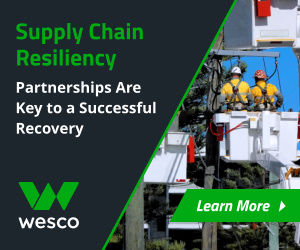Orchestration in the Energy Cloud
Mackinnon Lawrence is a research director leading Navigant Research’s Energy Technologies and Utility Transformations programs. Jan Vrins is the global Energy practice leader at Navigant.
As utilities stare down multiple threats to core business and revenue streams, innovation has emerged as a key area of focus. Multiple new energy opportunities to grow customer and shareholder value are emerging.

In a survey for Public Utility Fortnightly's recent State & Future of the Power Industry report (July 2017), "market new energy and products and services" and "radically improve ability to innovate" were among the top-ranked transformations utilities should develop to prepare for sustained growth through 2030.
Utilities have innovated for decades in their traditional core business. But how best to pursue these new energy opportunities, and more importantly, embrace agile innovation principles to capture new value streams, remains a difficult challenge for a utility model that was originally designed to deliver universal access to electricity across the country.
Today, the economies-of-scale, steel-in-the ground, one-way delivery model is fading. In its place, a highly distributed, networked, dynamic, and more virtual energy ecosystem, in some respects, is emerging. In this new ecosystem, performance and choice command a premium.
At Navigant, we call this the Energy Cloud. Within the Energy Cloud, clean, distributed, intelligent, and mobile energy will dominate, while safe, reliable, and affordable power remains an ongoing requirement.
Value Shifts to the Edge of the Grid
 “Until now, the perceived threat to traditional utility business models focused on declining load growth.” – Mackinnon Lawrence
“Until now, the perceived threat to traditional utility business models focused on declining load growth.” – Mackinnon Lawrence
Increased penetration of DER is the most disruptive threat to traditional utility business models over the coming decade. That is the verdict of nearly half of the respondents to Public Utilities Fortnightly's State & Future of the Power Industry survey.
The result speaks for itself: the effects of distributed DER are industry-wide and will have a long-term impact on the existing industry. Navigant Research expects that new installed distributed energy resources capacity will grow three to five times faster than central station generation over the next decade. Utilities are feeling the impact today.
California-based SMUD predicts that soon, its customers' investments in energy efficiency and behind-the-meter DER such as rooftop solar will eclipse the utility's own investments in new energy resources and grid infrastructure.
Smart meter deployments and pervasive grid modernization initiatives signal a digitization trend that is well underway. But the emerging DER ecosystem, combined with distributed intelligence and analytics, is unlocking new opportunities. Each connected resource, device, node, and meter is producing a torrent of data.
 “Two objectives define success: accelerating time-to-market readiness and producing high quality initiatives.” – Jan Vrins
“Two objectives define success: accelerating time-to-market readiness and producing high quality initiatives.” – Jan Vrins
For this reason, data are quickly replacing electrons as the new grid commodity, unlocking the full potential of an intelligent grid. Putting this data to work, utilities can provide better services to their customers, offer new products and services through sophisticated insights, and improve the operations of the grid.
Machine learning applications, a subcategory of artificial intelligence, are increasingly seen as a critical component of utility digitization and automation efforts. As these systems reach greater levels of sophistication and are linked together, a fully autonomous and self-healing distributed grid will emerge.
Meanwhile, energy production, consumption, and storage are becoming increasingly mobile. The impact of electric vehicle adoption on the grid, for example, will be significant.
Electrification of transportation offers the most revenue growth potential for utilities among emerging, so-called, exponential technologies, according to the survey respondents in Public Utility Fortnightly's State & Future of the Power Industry.
Global electricity consumption by highway-capable road vehicles is expected to exceed two hundred terawatt hours by 2030, according to Navigant Research, and the U.S. is projected to account for roughly a quarter of this. The load is dynamic and moves around the grid, adding significant complexity to the current intermittency challenges.
These broad trends portend a significant recalibrating of the grid's center of gravity further downstream. Under Navigant's Energy Cloud scenario, the retail segment of the grid value chain is expected to triple in value by 2030.
By contrast, with an expected two to three percent compound annual growth rate, growth within the generation segment is expected to barely keep pace with inflation.
The Emergence of Energy Cloud Platforms
Until now, the perceived threat to traditional utility business models focused on declining load growth caused by distributed generation and energy efficiency, utility-scale renewables, and digitization. Although these trends are impacting utilities, we see a much larger transformation happening.
Increasingly, one-off technologies are recombining into complex hybrid energy ecosystems supported by rapidly evolving technology platforms: integrated DER, transportation-grid nexus, buildings-to-grid, smart cities, energy Internet of Things, and transactive energy, for example.
As described in Navigant's recent white paper, "Navigating the Energy Transformation: Building a Competitive Advantage for Energy Cloud 2.0," these ecosystems pose a threat to the traditional utility business.
Within each of these energy ecosystems (also known as Energy Cloud platforms), clients' needs and value streams are evolving. These include new energy products and services, associated enablers such as applications and data, as well as underlying physical assets.
To capture value within these Energy Cloud platforms, at a minimum, successful companies will need to integrate and innovate across the platform. The most significant growth opportunities, however, will come from orchestrating these networks.
As demonstrated by Facebook, Uber, Airbnb, and other fast-growing ventures, network orchestrators leverage digital connectivity and deliver value through relationships or network capital.
By creating a platform that participants use to interact or transact across the network, these companies may sell products, build relationships, share advice, give reviews, collaborate, and more.
By now, many utilities have invested in innovation, research and development, and new technologies. They accomplished this internally, through acquisitions or via strategic partnerships. Utilities should continue this approach while ensuring that emerging technologies, products, and services are integrated with existing infrastructure.
At the same time, utilities must transform their organizations to capitalize on network orchestrator opportunities across Energy Cloud platforms. This will require creativity, end-to-end strategy, planning, and retooling operations.
Within the smart cities platform, for example, utilities should aim for product diversity. As with any successful organization, they must build multiple value streams within emerging technology ecosystems like transportation, connected buildings, and communication. New talent, a different mindset, and updated strategy and planning tools are needed.
And finally, the hardest part: The traditional silos of the utility must be broken down to unleash sustainable innovation. The pace at which utilities can cultivate this culture will determine their success. This will enable utilities to realize the full operational and financial value of distributed energy while managing the impact of stranded assets.
The Energy Cloud Playbook
Utilities are not alone in targeting the disruptive potential of dynamic Energy Cloud platforms. Currently, many of the most powerful and consumer-savvy companies in the world - including oil majors, car manufacturers, telecom giants, and blue-chip IT - are staking their claims.
Outmaneuvering competition begins with implementing an Energy Cloud playbook.
Of all the stages included in the playbook, "Stage 5: Innovate" remains the most elusive and challenging.
First, many utilities remain hemmed in by a regulatory model still tuned to centralized generation and rate-based recovery over multi-decade timeframes. A third of respondents to Public Utility Fortnightly's State & Future of the Power Industry survey point to outdated regulatory models as the most significant stumbling block for an industry increasingly destabilized by forces outside its immediate control.
Second, the utility's core business remains focused on the delivery of safe, reliable, and affordable power. Utilities have established businesses and organizations around one or more of the core electricity value streams: generation, transmission, distribution, and retail. The Energy Cloud platforms and the new products and services within them impact the entire utility value chain. The transformation of the utility business runs wide and deep.
A Framework for Utility Innovation
While utilities are regarded as stable, relatively risk-averse entities, they have the potential to play a leadership role in adopting network orchestrator business models. Utilities are in the best position to capture the total value of the Energy Cloud platforms through full integration, while adapting the grid from a demand (generation) and operations (DER), perspective.
They hold the cards in three significant ways: scale, access to capital, and an existing relationship with the consumer. This generally translates into longer runways for experimentation and the flexibility to be more patient before realizing returns. And they have solid advantages over startups operating under greater restraints.
Marshalling these assets effectively means fostering an agile innovation mindset. Innovation begins with culture. A culture with a propensity toward innovation requires strong leadership. Building cross-functional teams with a clear understanding of the organization's risk threshold, authority to drive initiatives forward, and an expectation of engagement without penalty is the launching point for utility leadership.
With this structure in place, three interrelated phases of activity must be unleashed: survey, test, and adapt.
Borrowing from principles of agile innovation, this process is designed to be highly iterative, enabling rapid adaptation to unfamiliar and turbulent environments. The ability to deliver on two objectives defines success: accelerating the time-to-market readiness and reliably producing high quality initiatives.
Phase 1: Survey
How is the environment around your utility business changing? What are the potential pathways for market evolution? Where do your utility's strategic advantages lie?
Utilities must ramp up their learning capacity. No organization on its own can effectively keep pace with the degree of change occurring in our industry today. Information flows too quickly. Innovation is increasingly exponential. Utilities cannot dictate the direction of market evolution. Disruptive forces will only increase in impact and frequency in the future.
At the same time, the regulatory and policy landscape is becoming increasingly complex. Momentum continues to favor clean and distributed opportunities. However, different approaches and sharp disagreements about the mechanisms of support present conflicting market signals.
For example, while the federal government under the Trump Administration has opted out of the Paris Accord, some U.S. states with large economies, including New York and California, are pushing forward with their own initiatives. Many U.S cities, as well as large corporations, have followed suit.
To keep pace, gather intelligence from outside your organization, collaborate with other utilities, partner with innovators small and large, synthesize with internal expertise, and challenge fiercely held assumptions within the utility culture to identify emerging opportunities.
No matter how deep your dedicated team and sophisticated the tracking tools within your organization, organizational culture and inertia will temper creativity and outside-the-box thinking.
Successful businesses have much to lose by challenging the status quo. You must understand the landscape in which you operate fully and consistently inject new thinking to fuel your organization's innovation muscle. This means being willing to move ahead of policy and regulation if the long-term health of the business demands it.
Phase 2: Test
What portfolio of solutions can your organization reasonably deploy today? What mechanisms does your organization have in place to tolerate failure and to improve upon the lessons learned? What processes do you have in place to scale up or down solutions?
Utilities must mine their intelligence to build out a portfolio of potential solutions that cater to the rapidly changing energy ecosystem around them. These potential solutions should be challenged and tested internally.
Holistic incubation across the organization will ensure ideas are cross-populated, but solutions must remain flexible to leave room for adjustments in real-time. Horizons are short, and viability needs to be tested continuously so as not to miss out on the right opportunities.
For regulated utilities, engaging the staff responsible for legal, regulatory, and compliance issues within the organization early in the process is recommended. These staff members are the gatekeepers that can derail initiatives after they are fully baked.
Give them a say early in the process to offer potential solutions, to avoid resistance after more resources have been sunk into a project. Leverage the intelligence-gathering efforts in the survey phase to keep tabs on how your competition is innovating. This can help internal legal and regulatory experts buy into the process.
Once the best solutions are deployed, feedback should be gathered, strategy refined, and finally assessed against benchmarks for success. If innovation tells us anything, it is that most initiatives are bound to fail, or worse yet, return just enough in revenue to sustain interest and occupy resources for several years before flaming out.
For this reason, the test phase must embrace the ability to fail fast, early, and often. This is where cultural agility can be an asset. It is perhaps the most challenging aspect for utilities.
Finally, successful initiatives are integrated into the product portfolio. This portfolio can expand and contract based on ongoing feedback from the market.
Phase 3: Adapt
How will you embed a culture of innovation in the DNA of your organization? What capabilities should your organization cultivate to remain viable in the future? What combination of technology platforms offers the most opportunity to leverage your organization's core strengths?
Utilities today are exposed to an increasing diversity of technologies, deployed in novel ways. Cleaner, more distributed, increasingly intelligent, and mobile energy breakthroughs are eroding the very foundation of the utility business. Energy remains at the core with many potential ancillary or value-added services accessible on a single platform.
Tesla, Nest, and other innovative startups (and established companies such as Ikea, BMW, Daimler, and others) have now proven a major point. Well-designed, consumer-targeted products are challenging traditional notions around consumer willingness to embrace nuance and choice in how electricity is consumed. Consumer electronic manufacturers have responded by developing more specialized gadgets that cater to a rapidly expanding connected home market.
This is just the tip of the iceberg. Disruptive business models emerging outside of energy, such as retail, media, and finance, are leveraging technology synergies to completely transform traditional market structures. Typically, digital capabilities are coupled with algorithms and a network of assets.
These tectonic industry shifts have all occurred within the past decade. For utilities, the most lucrative opportunities will lie at the intersection of multiple trends. Exploiting these opportunities means being ready to embrace constant change and a willingness to be an early mover as the market evolves.
Incorporating Innovation Best Practices
Continuous adaptation to opportunities around clean, distributed, intelligent, and mobile energy is completely at odds with utility culture. For this reason, the survey, test, and adapt phases of innovation should be pursued in two parallel tracks so one is not undermined by the other.
The first track requires the utility to develop more efficient and cost-effective solutions to optimize the current business and revenue streams. This will ensure that the core business remains resilient while freeing up human and financial resources to invest in new opportunities. Utilities are already adept at this first track and regulatory models or market mechanisms are mostly supportive of these efforts.
The second track is more challenging, and requires a significant departure from well-worn norms of utility strategic planning. This effort will need to focus on lucrative, high-growth opportunities around network orchestration of Energy Cloud platforms with a ten to fifteen-year planning horizon in mind.
Then, opportunities and initiatives should be reviewed and brought to market in much shorter timeframes than utilities are accustomed to. Three to six months is a reasonable period. These initiatives may bolster the core business. Even better, they could produce solutions that cannibalize the core business while positioning the organization to grow revenue and shareholder value.
What is required is a strategy and executive commitment, a shift in mindset, innovation leadership. Also needed are people that have done this before in other industries. Bring them into your teams. And finally, change your strategy, planning, and decision-making processes by incorporating innovation, valuing new ideas, and adapting different risk profiles going forward. Fail and fail fast.
Implementing a program around the second track tomorrow, however small, will pay dividends for your organization long-term. This effort must be continuously executed to increase the odds of long-term viability. Consider it the power of compounding innovation.



